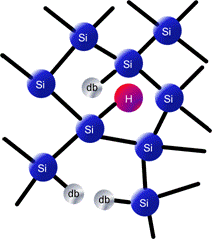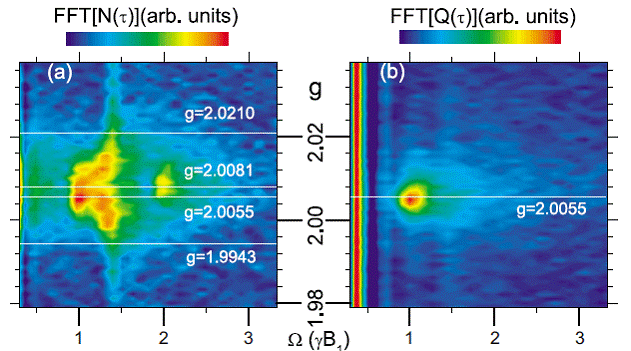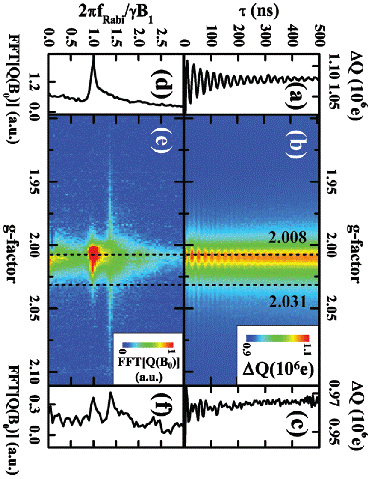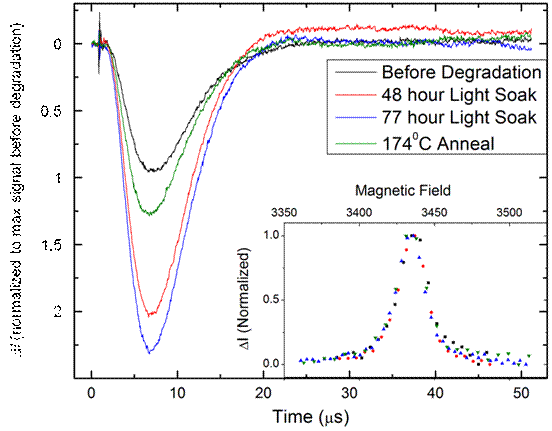www.acsprf.org
Reports: DNI1048916-DNI10: Mapping of Recombination Mechanisms in Hydrogenated Amorphous Silicon with Coherent Spin Control -- a 21st Century Approach to Unsolved 20th Century Solar Cell Efficiency Challenges
Christoph Boehme, PhD , University of Utah
The goals of the project have been (i) to observe coherently manipulated spin-dependent charge carrier transition rates in hydrogenated amorphous silicon (a-Si:H), a highly defective thin film semiconductor material that is used for solar cell applications (see sketch in Fig. 1a); (ii) to use these so called pulsed electrically and pulsed optically detected magnetic resonance techniques (pEDMR and pODMR, respectively) in order to categorize (map) the different charge carrier recombination mechanisms; (iii) use pEDMR in order to explore the dependence of dangling bond recombination dynamics on the degradation state of the amorphous semiconductor materials. Efficiencies of a-Si:H solar cells degrade significantly during light exposure. This effect (the so called Staebler-Wronski effect) has been known to be related to dangling bond (db) states in the a-Si:H. When a-Si:H is exposed to light, the db-density and thus, db-recombination increases, and device efficiency decreases. The Staebler-Wronski effect is fully reversible by heat. Anneal of a-Si:H leads to a db reduction. One aim of this project was to compare the dynamics of db-recombination of non-degraded, degraded and annealed a-Si:H.
Fig. 1: (a) Stick and ball illustration of a-Si:H. In contrast to crystalline silicon, a-Si:H has a strong distribution of bond angles and bond lengths which leads to hydrogen bonded or unsaturated silicon bonds. (b) Band diagram of a-Si:H. The presence of defect related localized band gap states is responsible for many different recombination mechanisms.
At the conclusion of this 32 month project (01/01/2009 08/31/2011) we have successfully achieved all planned experiments. A-Si:H thin film solar cell devices suitable for pEDMR measurements were developed in collaboration with MV Systems, Inc., the industry partner of the project. The comparative mapping between pEDMR and pODMR on a-Si:H revealed geminate and non-geminate recombination processes [1] as shown in the plots of Fig. 2 and explained in the caption. In addition, specific pEDMR probeheads were designed for the a-Si:H thin film samples which unexpectedly turned out to be very useful for experiments on organic thin film semiconductors which are used for similar applications as the inorganic a-Si:H [2-4,6-7].
Fig. 2: Plots of the optically (a) and electrically (b) detected recombination rate as a function of the magnetic resonance induced spin-Rabi nutation frequency W and the g-factor of the recombining charge carriers [1]. The measurements were conducted on identical a-Si:H films and under identical conditions. The optically detected measurement shows a variety of different recombination channels while the electrically detected data reveals recombination for one g-factor and one nutation frequency only. Thus, most of the optically detected recombination does not influence the conductivity. It is geminate recombination. Note that g is the gyromagnetic ratio, B1 the strength of the electromagnetic field that drives the Rabi oscillation.
During the second year of the project, charge carrier recombination in nitrogen doped a-Si:H (non-stoichiometric silicon rich silicon nitride, a-SiNx:H) was investigated. A-SiNx:H was anticipated to oppress recombination of geminate charge carrier pairs and degradation due to the Staebler-Wronski effect. PEDMR measurements as shown in Fig. 3 reveal surprising insights: The signal components of recombining charge carriers (dipolar coupling, exchange, weak etc.) strongly differ from pEDMR of a-Si:H but they are similar to the pODMR signals (see Fig. 2a). This indicates that similar electronic processes take place in a-Si:H and a-SiNx:H, however, many geminate processes of a-Si:H are non-geminate in a-SiNx:H. This confirms the hypothesis that charge carriers can easier dissociate in a-SiNx:H into nonn-geminate pairs.
Fig. 3: (a) The pEDMR detected recombination rate of dbs in non-stoichiometric a-SiNx:H ([N] = 23 at.%) [5], plotted for the time and the frequency domain as a function of the g-factor. (b) Plot of pEDMR measured spin-dependent recombination rates through db defects in a-Si:H for different anneal states of the material.
Finally, the degradation dependence of db-recombination was investigated. Figure 3(b) displays db-recombination transients measured on the same device in the undegraded state, two different degraded states (48, 77hours), and the annealed state. As expected, the magnitude of the recombination current increases with degradation and decreases with anneal. Surprisingly though, the degradation neither affects the dynamics (decay constants) of recombination nor the line shape of the db-ensemble (see inset). This is strong evidence that degradation induced dbs are not of different microscopic nature than the dbs of the nondegraded material.
The funded project enabled an excellent physics graduate student, Mr. Sang-Yun Lee, to complete his PhD thesis. Mr Lee graduated in July 2011, two month before the end of the project. So far, the work accomplished through this project has contributed to six publications in Physical Review B, Physical Review Letters, Physica Status Solidi B, a book chapter, the Journal of the American Chemical Society and Applied Physics Letters. The paper in Physica Status Solidi B was highlighted on the Journal title page and this Journal title was later awarded the Title of the Year of the Physica Status Solidi journals. Currently, one additional manuscript has been submitted for publication in Physical Review B, and at least one additional manuscript is expected to be prepared and submitted for publication in the months after completion of the project.
This project has significantly contributed to the expansion of the spectroscopic capabilities and the range of investigated materials in the PI's lab. Much of the work has led to further funding from other sources such as two National Science Foundation projects (including one CAREER Award) and one project supported by the U.S. Department of Energy. A large $21Mio Center of Excellence for Materials Research and Innovation (CEMRI) grant that was awarded by NSF to the University of Utah in September 2011 was also in part due to the preliminary work on method development that came out of this project. Beyond its scientific impact, this project has certainly also significantly contributed to the early promotion as well as the early award of tenure to the PI by the University of Utah in July 2010.





